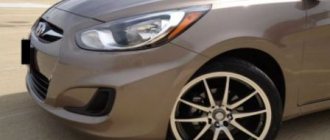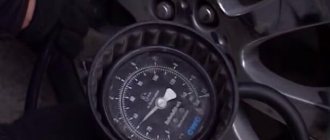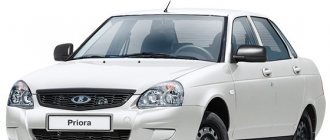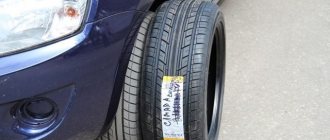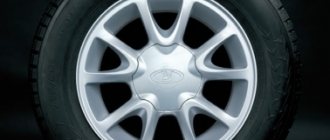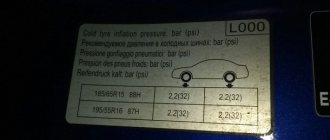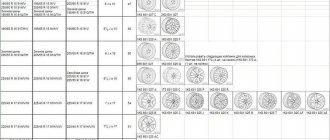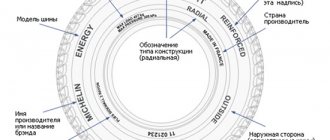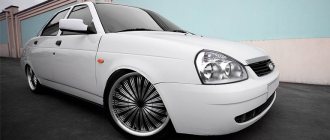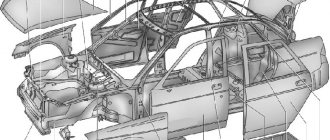05 December 2014 Lada.Online 130 411 8
An experienced driver knows how important it is to periodically check the pressure in your car's tires. If the pressure does not correspond to the recommended one, this leads to accelerated tire wear, as well as a deterioration in the stability and controllability of the vehicle. The table shows the recommended tire pressure for the Lada Granta.
What happens if tire pressure is not maintained?
Most cars with front-wheel drive (both domestic and foreign production) can be equipped with rims with a radius of R13 - R16. However, the basic package almost always includes wheels of sizes R13 and R14. The optimal pressure in a car's tires is selected according to its weight when fully loaded. In this case, the climatic and road conditions in which the vehicle is operated must be taken into account.
If the wheels are not inflated correctly
- Driving the car will become difficult; you will have to exert more effort to turn the steering wheel;
- tread wear will increase;
- fuel consumption will increase while driving on flat tires;
- the car will skid more often, which is especially dangerous when driving in icy conditions or on a wet road;
- there will be a decrease in the dynamic power of the vehicle due to a constant increase in the force of resistance to movement.
If the wheels are overinflated
- The wear of chassis parts increases. At the same time, while driving, you can feel all the bumps and holes on the road. Comfort when driving disappears;
- Since the tire pressure of the car becomes excessive, as a result, the contact area of the tire tread with the road surface decreases. Because of this, the braking distance significantly increases and the safety of vehicle operation decreases;
- the tread wears out faster, significantly reducing the service life of car tires;
- Excessive pressure in tires upon contact with an obstacle at high speed can cause the formation of a hernia, or even rupture of the rubber. This situation is extremely dangerous and can lead to tragic consequences.
Most owners of transport equipment with R13 and R14 wheels (the most common radius sizes) are interested in: what should be the optimal pressure in the car tires? According to the manufacturer's recommendation, tires of the thirteenth radius must be inflated to 1.9 kgf/cm 2, and wheels of size R14 - to 2.0 kgf/cm 2. These parameters apply to both front and rear wheels.
Dependence of tire pressure on climatic and road conditions
In principle, it is necessary to maintain the same tire inflation in both summer and winter. However, it is recommended to slightly underinflate the tires in winter. This is necessary for:
- Increasing vehicle stability on slippery roads. Driving a vehicle becomes more convenient and comfortable with slightly flat tires in winter.
- Road safety is improved because the vehicle's braking distance is significantly reduced.
- Lowered tires in winter soften the suspension, making the poor condition of the road surface less noticeable. Increases comfort when moving.
You also need to know that with a sharp change in temperature (for example, after the car has left a warm box in the cold), due to certain physical properties, the pressure in the tires decreases.
Therefore, before leaving the garage in winter, it is necessary to check the tire pressure and, if necessary, inflate them. Do not forget about constant monitoring of pressure, especially when the temperature changes and in the off-season.
The recommended pressure in R13 tires with the onset of summer is 1.9 atm, this value is calculated taking into account the fact that the car will be half loaded (driver and one or two passengers). When the vehicle is fully loaded, the pressure of the front wheel pair must be increased to 2.0-2.1 atm, and the rear wheel pair - to 2.3-2.4 atm. The spare tire should be inflated to 2.3 atm.
Unfortunately, the road surface is by no means ideal, so most motorists specifically prefer not to inflate their tires a little. Because thanks to this, all the unevenness and imperfections of the road are not so felt when driving. Often in summer the tire pressure is reduced by 5-10%, and with the onset of winter this figure increases slightly and amounts to 10-15%. When driving on roads with smooth surfaces, it is best to maintain the tire pressure recommended by the manufacturer.
Taking into account all factors, a tire pressure table is constructed.
| Disc size and radius | Tire pressure, kgf/cm2 |
| 175/70 R13 | 1,9 |
| 175/65 R13 | 1,9 |
| 175/65 R14 | 2,0 |
| 185/60 R14 | 2,0 |
What should be the optimal pressure for larger wheels?
Despite the fact that most domestic and foreign cars have wheels with a maximum radius of R14, most owners, in order to improve the appearance of their vehicle and improve some of its characteristics, install wheels of a larger radius (R15 and R16). Therefore, it is necessary to know what the optimal pressure should be for tires of this size?
Here, too, everything depends on the degree of loading of the machine. When it is half loaded, the tire pressure threshold should not exceed 2.0 kgf/cm2; when fully loaded, this value is already 2.2 kgf/cm2. If a large amount of various heavy luggage is transported in the luggage compartment, the pressure in the rear wheel pair must be increased by another 0.2 kgf/cm 2 . As you can see, the pressure in tires of the fourteenth radius is approximately equal to the pressure in R15 and R16.
What does the size of tires and wheels affect?
| Increasing the diameter of the disk | Increasing the width of the disk | Increasing tire width | |
| Car style | will improve | will improve | will improve |
| Road holding | will improve | will improve | will improve |
| Steering precision | will improve | will improve | will improve |
| Tire grip | Will not change | Will not change | will improve, but only on dry roads |
| Resistance to hydroplaning | Will not change | Will not change | will get worse |
| Comfort on rough roads | will get worse | Will not change | will improve |
| Road noise | Will not change | Will not change | will intensify |
| Gasoline consumption | Will not change | will increase | will increase |
| Tire wear | Will not change | Will not change | will increase |
Tires for the Lada Largus: how to choose, sizes, pressure
It is worth noting that it is better to choose winter tires for the Lada Granta as narrow as possible. Thus, the pressure of the car on the road surface will be greater, and therefore the grip on the road will improve. Also, do not forget that wide tires are more sensitive to the ruts on the road, and low-profile tires will transfer even the smallest bumps to your butt.
The smaller the unsprung masses
(this includes a lot of tires and wheels), the better the car will hold the road and accelerate faster. For example, if you put wheels on a car that are 2 kg lighter each, then acceleration to 100 km/h will be reduced by 0.2 seconds.
Attention! Installing larger wheels may lead to problems with ABS and ESC calibration (the systems may not work correctly). Let us remind you that for safety and to increase the service life of your tires, you should maintain the recommended pressure in the Lada Granta tires
Let us remind you that for safety and to increase the service life of your tires, you should maintain the recommended pressure in the Lada Granta tires.
Keywords: Lada Granta wheels | Lada Granta tires | Lada Granta Sport
25
-1
Found an error? Select it and press Ctrl+Enter..
How to measure blood pressure: the correct sequence
Alas, even the majority of experienced drivers completely ignore the procedure for monitoring the tire pressure of a car, considering this procedure absolutely useless. Checking tire pressure is carried out using a pressure gauge, which can be integral with the pump, or be a separate element. Do not forget that the error of any pressure gauge is usually 0.2 kgf/cm 2.
Pressure measurement sequence:
- It is necessary to reset the pressure gauge readings.
- Unscrew the safety cap (if equipped) from the wheel nipple.
- Connect the pressure gauge to the nipple and press it lightly to release air from the chamber.
- Wait until the instrument needle stops.
This procedure must be performed monthly during regular use of the vehicle. The measurement should be taken before leaving, when the tires are not yet warmed up. This is necessary to accurately determine the readings, since after the tires warm up, the air pressure inside them increases. This is often caused by dynamic driving with constant changes in speed and sudden braking. For this reason, it is ideal to take measurements before driving, when the tires on the car have not yet warmed up.
Wheel parameters - Lada Granta, wheel size for Granta
{ "first": , "options": , "selected": NULL, "form_name": "s" }
| { "first": , "options": , "selected": NULL, "form_name": "s" } | { "first": , "options": , "selected": NULL, "form_name": "s" } | { "first": , "options": , "selected": NULL, "form_name": "s" } |
| { "first": , "options": , "selected": NULL, "form_name": "s" } |
| { "first": , "options": , "selected": NULL, "form_name": "s" } |
{ "first": , "options": , "selected": NULL, "form_name": "s", "name": "brand" }
{ "first": , "options": NULL, "selected": NULL, "form_name": "s", "name": "model" }
{ "first": , "options": NULL, "selected": NULL, "form_name": "s", "name": "year" }
{ "first": , "options": NULL, "selected": NULL, "form_name": "s", "name": "modification" }
{ "first": , "options": , "selected": NULL, "form_name": "s" }
| { "first": , "title": NULL, "options": , "selected": NULL, "form_name": "s" } | { "first": , "title": NULL, "options": , "selected": NULL, "form_name": "s" } |
| { "first": , "options": , "selected": NULL, "form_name": "s" } |
| { "first": , "options": , "selected": NULL, "form_name": "s" } |
{ "first": , "options": , "selected": NULL, "form_name": "s" }
| { "first": , "options": , "selected": NULL, "form_name": "s" } | { "first": , "options": , "selected": NULL, "form_name": "s" } |
| { "first": , "options": , "selected": NULL, "form_name": "s" } | { "first": , "options": , "selected": NULL, "form_name": "s" } |
{ "first": , "options": , "selected": NULL, "form_name": "s" }
{ "first": , "options": , "selected": NULL, "form_name": "s", "name": "brand" }
{ "first": , "options": NULL, "selected": NULL, "form_name": "s", "name": "model" }
{ "first": , "options": NULL, "selected": NULL, "form_name": "s", "name": "year" }
{ "first": , "options": NULL, "selected": NULL, "form_name": "s", "name": "modification" }
Is it worth it or not to inflate your tires with nitrogen?
Recently, almost all tire stations have introduced the expensive service of filling tires with nitrogen. Its popularity is due to a number of the following opinions:
- Thanks to nitrogen, the pressure in the tires remains unchanged when they heat up.
- The service life of rubber increases (it practically does not “age”, since nitrogen is much cleaner than air).
- Steel wheel rims are not subject to corrosion.
- The possibility of tire rupture is completely eliminated, since nitrogen is a non-flammable gas.
However, these statements are nothing more than another advertising ploy by marketers. After all, the nitrogen content in the air is about 80%, and it is unlikely that anything can change for the better if the nitrogen content inside the tires increases by 10-15%.
In this case, you should not spend extra money and inflate the wheels with expensive nitrogen, since there will be no additional benefit, as well as harm, from this procedure.
Not every driver pays attention to the pressure in the tires of his car. But safety on the road, controllability and maneuvering of the car sometimes depend on the pressure in the tires. In addition, the level of tire pressure affects:
- on fuel consumption,
- uniform wear of the wheel itself,
- may cause hernias on the wheel court.
If the pressure in tires r13 and r14 is increased, then, for example, when hitting an obstacle, the tire may even explode. Incorrect tire pressure r15 will also affect maneuverability when cornering, turning, etc. The following figure will best show the different levels of inflation of car wheels.
Tire pressure
As you can see, just by the wear of the tread you can determine what the problem is with inflating the rim, but it is better not to let it get to that point, but to maintain a certain atmosphere at the required values.
Tire pressure must be checked at least once a month. Professional drivers check every 2 weeks and before each long trip. And an external inspection of the wheels should be done daily before starting the car engine. Although if you are the happy owner of low-profile tires, then it is impossible to determine what pressure should be in the tires by eye.
Sphere of influence of tires and wheels
The answer to the question regarding the equipment of the Lada Kalina: which wheels are suitable can be found in the manufacturer's instructions. The factory documentation for Lada Kalina indicates three types of tires recommended for installation:
- one of the popular options, also installed on classics, is 175/70R13 tires;
- the most common tire size today is 175/65R14;
- another standard option is 185/65R15.
The plant also allows the Lada Kalina to be equipped with 185/60R14 and 185/55 R15 tires.
What size tires are Lada Kalina Cross? It is recommended to install tires with overall dimensions of 195/55R15 on this model.
For the Lada Kalina Sport car, the factory has established its own standards:
- 185/55R15 or 195/50R15;
- 195/50R16;
- 205/40R17.
To understand which tires are best suited for the Lada Granta, you first need to find out what the size of the tires and wheels of the car affects. Service station specialists note that when replacing tires, one should be guided by the fact that the difference in outer diameter is minimal.
The selection of tires affects the following features of vehicle operation:
- brake and traction characteristics;
- transmission;
- fuel consumption;
- atmospheric emissions.
| Tire increase | Disc enlargement | Wheel enlargement | |
| Steering precision | |||
| Tire grip on wet roads | |||
| Tire grip on dry roads | |||
| General driving comfort | — | — | — |
| Fuel consumption | |||
| Wear rate | |||
| General management indicators |
Symbols: - improvement, - - deterioration, 0 - no change.
Changing your tire size will definitely lead to changes in your vehicle's handling accuracy. As the volume of the tire becomes larger, the scale of the space in contact with the road surface increases. This provides ample opportunities for maneuverability.
According to the factory specifications, the original tires supplied from the factory have a radius of R14 and R13. R14 is a fairly classic option for small cars. Both wheels and tires with these dimensional characteristics are inexpensive and are quite easy to find on the market. The situation is similar with the R13. Therefore, when analyzing which discs are suitable for the nagrant, you should keep this point in mind.
Size characteristics of tires and wheels, which are also suitable for LadaGranta Currently, all AvtoVAZ models with front-wheel drive are equipped with R15 size wheels. And although the original Lada Granta R15 tires with this wheel model have dimensional characteristics of 185/55, they will also fit well with tires 175/70, 185/60 and even 195/55.
Lada Granta Sport tires have a factory size of R16. The dimensions of the tire itself are 195/50. On the Grant Sport, the tire size dictates that the rack is shortened, allowing even the smallest wheel to fit into the space for it. With this wheel diameter you can safely install tires of sizes 175/50, 184/45 and even 195/40.
Tires for winter use must have soft contact with the road surface, which will provide a reliable degree of traction even on packed snow, and the tread base must be rigid for precise steering. Goodyear, Pirelli and Dinlop Winter companies have the necessary dimensional characteristics for the Lada Granta, namely in the range from R13 to R16.
Winter tires will also require running-in to ensure they fit firmly in their seats. For a good break-in, you will need to drive about 500 kilometers. When running in, you should try to avoid sudden braking and slipping. To improve traction, it is also recommended to choose tires with a narrow profile.
Which wheels to choose: with or without a tube?
In recent years, tire fitting and car repair specialists have been advising the purchase of tubeless wheels. But just a decade ago it seemed fantastic. Today, the use of tires with tubes is a rare occurrence, and in a couple of years, wheels with a tube inside will probably only be found on bicycles.
A tubeless tire has better wear-resistant characteristics due to increased vulcanization. Due to their lighter weight, their technical characteristics are better due to lower inertia. In addition, a tubeless tire balances better. Their service life is also longer. In addition, in the event of a puncture, the tubeless tube will hold air longer, which will allow you to safely get to the service center.
Also, we will not consider the issue of driving in winter on winter tires with studs and greater tread depth, because... this affects your safety and the safety of not only the car, but the life and health of others. Therefore, in the summer we use summer wheels and no “all-season” tires during other periods, unless you live in snowless Europe. The choice of tire manufacturer brand is your choice; the only thing worth paying attention to is that the radius of the wheels must exactly match that recommended in the vehicle’s service book.
What to choose
For each driving style, you need to choose tires that suit your driving style. Prior owners must decide for themselves which summer and winter tires are best to choose.
For those who have a more aggressive driving style, it is better to take wide tires, but the problem is that tires of this type are intended only for asphalt - such tires will not be of any use on dirt or wet country roads. The negative aspects of such rubber are increased noise in the cabin and extreme rigidity, which can have a bad effect on the suspension.
For owners whose style is the most relaxed, it is better to purchase softer tires, designed for soft and comfortable movement on any road. The disadvantages of soft tires are that the steering response is slightly slower or the braking distance may be slightly longer.
As a result, every owner of a Lada Priora should have a summer and winter set of tires. And what brand the tires will be, what the pressure will be and what tires are right for you - it’s up to you and no one else to decide. The main thing is not to violate the recommendations of the manufacturer and not to drive recklessly on the roads - after all, the most important thing in any car is the safety of the driver and passengers.
Lada Priora is a domestically produced car. To ensure safe driving, it is recommended to select the correct tires in accordance with the wheel sizes and season.
The Lada Priora car has been produced since 2007. The manufacturer recommends selecting tires in accordance with the size of the wheels and engine power. If the engine has a displacement of 1.6 liters and 8 valves, then it is recommended to install tires of sizes 185/60 R14, 175/65 R14, 185/65 R14 on a 14-inch wheel.
ATTENTION! A completely simple way to reduce fuel consumption has been found! Don't believe me? An auto mechanic with 15 years of experience also didn’t believe it until he tried it. And now he saves 35,000 rubles a year on gasoline! Read more"
If the vehicle has a 16-valve engine with a displacement of 1.6 liters and a power of 72 kW, then it is recommended to use tires with dimensions:
The manufacturer recommends using tubeless and radial tires. He recommends using rubber that is about 185 millimeters wide. They are installed on a disk with a diameter of 14 inches.
What tire pressure should be?
You don’t need to be a professional to answer the question: “How to measure tire pressure?” The pressure in car tires is measured with pressure gauges, which can be dial, mechanical and digital (electronic). For the best result, it is necessary to measure on a cold car, before driving, because... During operation, the wheels heat up, and therefore the pressure increases. You need to measure all four wheels with a pressure gauge, because... pressure can be different everywhere. Very often, the pressure gauge function is installed in pumps (compressors) for inflating car tires. Compressors are connected either to the car's cigarette lighter or to the battery terminals.
Tire pressure is indicated in atmospheres. The atmosphere is the value of kilogram per square meter. Typically, recommendations on what pressure in the tires of a car should be indicated in the car’s service book. Also, recommended atmospheric pressure values can be placed on a sticker located either on the gas filler door or on the pillar next to the driver.
Factors to consider
Firstly, it is safety. It is not for nothing that the manufacturer prescribes a specific pressure value for tires. When driving at low speeds, for example up to 60 km/h, this will not have much effect, but if you are a speed lover, then it is better not to experiment. Tires with pressure even slightly less than the nominal pressure will worsen the vehicle's handling at high speeds and also increase its braking distance.
Less pressure - more flow
Secondly, lower tire pressure means greater rolling resistance, and therefore higher fuel consumption, as well as increased wear of the tread itself. Therefore, almost all tire manufacturers recommend that drivers regularly check the tire pressure of their car. This should be done at least once every three weeks.
Features of tire inflation in winter and summer
As mentioned above, you need to check the density of tires on a cold car. It is also better to inflate tires, especially in winter, not immediately after using the car, but when the wheels “cool down” a little. This rule applies to both winter and summer maintenance. In winter, we measure the pressure and pump up the tires no earlier than 2 hours after stopping. In summer, due to the high ambient temperature, cooling occurs much more slowly, this should also be taken into account. In winter, the ideal option would be to inflate tires in a warm box or tire shop; this will help to avoid differences in pressure, and in this case the indicators will be close to ideal.
Please note that if the car is fully loaded, the pressure in the tires will increase significantly, this should also be taken into account. Significant changes will also occur when the ambient temperature fluctuates greatly. Therefore, when the weather changes, you need to measure the tire pressure more often.
Review of the best summer and winter tires for Lada Granta
The most popular winter tires:
- Vredestein Wintrac Xtreme S - the tread consists of Velcro, which provides maximum traction on wet asphalt and loose snow. The maximum temperature of use is 25°C. The critical point is -35°. The average cost in online catalogs is from 8,500 rubles.
- Goodyear UltraGrip Performance Gen-1 - balanced price-quality ratio. The tire provides good traction on loose snow and ice at sub-zero temperatures. Average price from 7,000 rubles.
- Dunlop Winter Sport 5 is a soft compound rubber that is not susceptible to hardening when the temperature drops. The price of one tire is from 5,500 rubles.
- Pirelli Winter Sottozero 3 is a popular model among car enthusiasts in the CIS, including the Russian Federation. Good quality, technical specifications at an affordable price. The service life before replacement exceeds 60 - 70 thousand km. mileage The average price by region is from 5,000 rubles.
- Nokian WR D4 is an economical option for most car owners. High-quality grip, long service life, affordable price from 2900 rubles.
Summer tires for Lada Granta:
- Goodyear Ecient is a high-quality tire at a premium price from a European manufacturer. The tire warms up within a few seconds, providing the widest possible contact patch with the road surface. Rubber guarantees grip, control, cornering, and a minimum percentage of skidding at medium and high speeds. Average price from 5000 rubles.
- Grip Performance is a budget option from a European brand. Better than standard tires in terms of technical characteristics, acceptable for use in urban conditions. Price from 5500 rubles.
- Hankook Ventus Prime3 K125 is also a budget model with a price starting from 6,000 rubles. Above average quality at an affordable price.
- Dunlop SP Sport MAXX RT2 is a tire with unidirectional tread, which ensures high handling and minimal vehicle roll when cornering, regardless of weather conditions and temperature conditions. Average cost from 5200 rubles.
- Dunlop SP Sport MAXX RT - tires are similar to the previous ones, except that the tread pattern is asymmetrical. Price from 5100 rubles.
- Pirelli P7 Cinturato Blue - long service life is the main highlight of the rubber. The average service life exceeds 65,000 km before replacement. Average price from 5500 rubles.
Service station specialists strongly recommend changing tires strictly according to the seasons, and to a lesser extent using universal, all-season tires. The operating temperature range is several degrees lower than seasonal tires, resulting in reduced vehicle controllability.
Indexes and markings of tires on Lada Granta
To choose the right tire you need to be able to read the indices and other symbols on the tires, namely:
- “T” - the maximum permitted speed of movement is not more than 195 km / h. “H” - up to 205 - 210 km/h. It is not recommended to exceed the speed range, as there is a high probability of shooting, cord deformation, and, as a result, an emergency;
- “Q” - load capacity index: from 85 to 490 kg;
- “ET” is the metal rim bead extension coefficient;
- “KM” - partial and full load index: no more than three passengers, cargo in the trunk up to 50 kg;
- “M+S” - full load - more than three people and over 50 kg in the trunk.
What does the pressure in Lada Granta tires affect?
- Safety and comfort when traveling by car. Over-inflated tires become hard and produce a distinct knocking sound when they hit a hole or bump. There is a high probability that the metal rim will be deformed and the camber-toe angle will be disrupted.
- Fuel consumption: the lower the pressure, the more effort the engine needs to put in to rotate the wheel and move the car. In the case of overinflated tires, fuel consumption is within normal limits.
- Chassis and suspension of the vehicle: overinflated tires do not dampen impacts from unevenness and potholes, but fully transfer them to steering rods, ends, and ball joints. Thus, the elements of the steering system fail faster.
- Shock absorbers and strut pressure springs: similar to the steering rack, rods, and tips, the elements wear out faster due to systematic work. Sharp jolts and impacts cause the spring coils to burst, become deformed, and the shock absorber rod breaks the cylinder.
If you encounter any difficulties with repairs or diagnostics of components and assemblies, contact specialists from service stations, workshops, and service centers for help.
Source
When you need to lower your tires a little
In some cases, there are recommendations to slightly lower the tire pressure than specified in the recommendations. There are two such cases:
- In winter, if the pressure is a little less, then better traction occurs. But as the temperature changes, the internal volume in the tire also changes.
- The most popular use for slightly lowered wheels is off-road driving. In this case, the wheels will act on the principle of tracks. Which will increase cross-country ability.
But it is difficult for an inexperienced driver to determine by what indicators to reduce the pressure. Therefore, we do not recommend experimenting.
Conclusion: the pressure in car tires must be checked regularly, maintained at the level recommended by the manufacturer, and weather and road conditions taken into account. This will extend their life and help make your ride safer.
Tires Lada Granta
Properly selected car tires mean safe driving. Many drivers underestimate the importance of high-quality vehicle equipment, which results in frequent accidents, collisions, and roadside emissions.
Modern VAZ cars, including the Lada Granta, are equipped with rims with a diameter of R13, R14, R15, R16. The behavior of the car on the road depends on the size of the diameter. For moderate driving, the manufacturer recommends tires with a rim diameter of R15 as a universal option.
Calculation of the recommended value
How to use the calculator?
The calculator is working in test mode! If you find an error in the indicators or want to leave suggestions, please send them through the feedback form on the Feedback page or the VK group! Errors with evidence (photos, screenshots, links) are accepted! All information presented on the site is for informational purposes only! Thanks for understanding!
Contents
- 1 What pressure should the tires have?
- 2 How is tire pressure measured?
- 3 Instruments for measuring pressure levels
- 4 Where does the manufacturer indicate pressure standards?
- 5 Features of inflating car tires at different times of the year: winter and summer
- 6 Consequences of incorrect tire pressure selection
- 7 Tables of recommended tire pressures for different types of cars
What tire sizes does the manufacturer recommend to install?
The choice of tires is a real problem for most Lada Grant owners due to the fact that the “range of sizes” is limited. Driving for a long time on tires with inappropriate sizes leads to decreased vehicle control and emergency situations.
The transcript reads as follows:
- wheel rim width;
- surface diameter;
- reach length;
- tire width;
- height in percent;
- diameter of the metal rim.
The higher the disc is installed on the car, the greater the risk of skidding and reduced control efficiency. At the same time, excessively low wheels also negatively affect ground clearance, lower ground clearance, and limit the vehicle’s maneuverability.
The most suitable tire and wheel sizes are R13, R14, and R15 and R16 are intended exclusively for asphalt pavement and city roads. Driving on the periphery with rims of size R15, R16 is not advisable, since there is a high probability of deformation of the metal rim.
How is tire pressure measured?
On the territory of Russia, the Atmosphere (1 atm. = 1 kgf/cm²) is accepted as the unit of measurement of air pressure in tires. In the manufacturers' tables, the Atmosphere, due to its close value, is often equated to another unit - Bar (1 bar = 0.98 atm). American automakers indicate values in PSI (1 psi = 1 pound/square inch or pound/square inch). When marking car tires, manufacturers use Kilopascal (1 kPa = 6.895 psi) to indicate the maximum permissible pressure (MAX PRESSURE). Conversion of units of measurement is carried out using the formulas:
- 1 psi = 0.068 atm
- 1 atm = 14.696 psi
- 1 atm = 101.348 kPa
- 1 bar = 0.98 atm
Important! Normal tire pressure does not depend on the brand of tires, but on the brand of your car and the recommendations of its manufacturer.
| Technical atmosphere (at or at) = kgf/cm 2 | (BAR), bar | (PSI) Pound-force per square inch | (ATM), physical atmosphere | kPa (kPa), kiloPascal | |
| Technical atmosphere (at or at) = kgf/cm2 | — | 0,980665 | 14,223 | 0,96784 | 98,066 |
| (BAR), bar | 1,0197 | — | 14,504 | 0,98692 | 100 |
| (PSI) Pound-force per square inch | 0,070307 | 0,068948 | — | 0,068046 | 6,894745 |
| (ATM), physical atmosphere | 1,033 | 1,01325 | 14,696 | — | 101,348 |
Tire pressure indicators for Lada Liftback in summer
The manufacturer's hint regarding optimal pressure levels can be found on the driver's door center pillar. According to it, the number of atmospheres in such a car should be 2.0 atmospheres on all four wheels with a minimum load. The maximum load of the car provides for a change in indicators to 2.2 Bar on the rear axle and 2.0 Bar on the front.
In the summer, if the car is in a cool garage, the indicators will be the same, but when the car goes out into the heat, the amount of air in the tire will increase. Therefore, before the trip it is worth lowering the pressure by about 0.3 Bar. This way you can achieve the most correct parameters as stated by the manufacturer. The most important thing in this case is to monitor the behavior of the car. If the car skids when turning or excessive fuel consumption is noticed, then you immediately need to check the pressure and bring it to optimal levels. Otherwise you will have to buy new parts and tires.
Properly inflated tires
The pressure must be checked by the driver systematically. If you constantly forget about such a little thing, it can lead to many consequences. When driving a car on a busy highway with the wrong pressure, you can endanger not only yourself, but also other drivers and pedestrians.
Source
Instruments for measuring pressure levels
Switch
Mechanical, spring type. Relatively inexpensive, provides readings with an accuracy of 0.1 units
Rack and pinion
Coil spring. Reliable, affordable, easy to use
Digital
With digital screen. A more modern alternative to mechanical devices
Indicator cap
Miniature device for each wheel. Purchased as a set of four. Screws on instead of regular caps, works very clearly, the color of the indicator depends on the tire pressure
External cap sensors
Electronic tire pressure and temperature indicator. Modern high-precision online monitoring device
Important! Pressure measurements are taken before driving in “cold” tires, after several – at least 5, optimally 8 – hours of rest.
About tire pressure on Lada cars in summer and winter
Correct tire pressure is a very important aspect of driving safely. Although this indicator can be called relative, since it indicates the ratio of the proportion of air to volume, and does not simply measure its amount in the tire. But such measurements should be carried out constantly, because systematic monitoring will ensure driving safety and the durability of car components. Measurements are carried out using a special device called a pressure gauge. They come in different types and different accuracy classes. Therefore, for regular use it is worth choosing a high-quality device with a high accuracy class.
Features of inflating car wheels at different times of the year: winter and summer
Due to the fact that the air pressure in any enclosed space changes by 0.1 atm. When the temperature fluctuates every 8-10 degrees, winter and summer tire inflation have differences.
In the summer heat, due to significant - up to 40-50 degrees - heating of the road surface, increased adhesion to its surface and friction, the temperature and pressure in the wheels can seriously increase. To avoid the possibility of tire explosions and other emergency situations, when inflating wheels in the summer, you should consider:
- The increase in pressure in the wheels of a car with an increase in the temperature of the ambient air and road surface can reach 10-15%. It is better to “underinflate” the tires by a value corresponding to this percentage;
- when making control measurements, you need to take into account the increase in the period of temperature equalization inside and outside the wheels; it will be better if the car sits overnight;
- You can find out what the maximum pressure in the front and rear wheels should be for your car in summer and winter in the accompanying documentation from the manufacturer. The difference will average 0.1-0.2 bar.
In winter, cooling and cooling of the road surface leads to a significant drop in pressure inside the wheels of the car, which reduces its stability on the road. What are the features of inflating tires in winter:
- It is better to control pressure and inflate wheels in winter after the car has been standing in the open air for at least 2 hours;
- if the car was in a warm garage before leaving, calculate the temperature difference in the box and outside, and then for every 8-10 degrees difference, add 0.1 atm to the normal tire pressure value;
- If the weather has settled and the thermometer does not show significant fluctuations, when inflating the wheels, focus on the “winter” pressure indicators recommended by the car manufacturer.
Important! Even if you are not a professional driver, use a pressure gauge at least once a month, as well as before every long journey. When changing seasons with frequent temperature fluctuations, it is better to reduce this interval to at least 2 weeks.
What non-standard sizes can be supplied?
Non-standard sizes of winter and summer tires are acceptable on the Lada Kalina, if you choose them correctly among the entire range provided. At the moment, manufacturers have tried to expand the boundaries of their offerings in order to prove themselves to potential customers. The following options for non-standard winter and summer tires are distinguished:
- The R16 is a large diameter wheel, which raises the car's suspension slightly, resulting in a soft and smooth ride.
- Small radii are an opportunity to lower the vehicle, while emphasizing its practicality, but it is not recommended to use the car at such a low “landing” in impassable terrain, since there is a possibility of damage to the front and rear bumpers.
Summer tires differ from winter tires in that they remain stable on the track, despite the increased temperature of the surface, which heats up the rubber and can cause it to stick to the surface.
In winter, it is important to ensure good grip on slippery roads, while preventing the car from skidding on poorly cleaned road surfaces.
Consequences of incorrect tire pressure selection
The deviation of tire pressure from optimal values should not be underestimated; in most cases it leads to negative consequences. Let us consider separately both options for changing the norm.
Low pressure
When the pressure gauge readings decrease, contact of the wheel with the road is ensured only at the extreme points of its surface. This is practically impossible to determine visually, but this situation leads to a number of troubles:
- the load on the side tracks of the tread increases, uneven rapid wear occurs;
- grip on the road surface deteriorates, acceleration is delayed, braking distance increases, and the likelihood of skidding increases;
- at high speeds, “wave formation” occurs in the side parts of the tires, which interferes with stabilizing the car in a critical situation, and also leads to destructive vibration of the tire frame;
- fuel consumption increases.
High blood pressure
When the pressure gauge readings exceed the optimal value, the wheel comes into contact with the road surface only with its central part. As a result, the following happens:
- adhesion to the road surface decreases, wheel rigidity increases, and accelerated wear of the central tracks of the tire occurs;
- when colliding with uneven surfaces, there is a risk of tire rupture;
- the load on the chassis and body increases;
- The noise level increases and ride comfort decreases.
Different pressure
However, the worst situation is when the pressure readings on all wheels are different. In this case, the car tilts towards the least inflated wheel. Fuel consumption can increase up to 10%.
At the same time, there are a number of cases when a deliberate deviation of tire pressure from the norm by 10-12% can resolve a difficult situation. For example, lowering can help out on potholes, sand, sticky mud or wet grass - the wheel artificially becomes soft and behaves like caterpillars, increasing maneuverability. A slight pumping is indicated when driving on highways at high speeds. The addition of atmospheres for the rear wheels makes it easier to carry loads.
Review of the best summer and winter tires for Lada Granta
Lada granta liftback technical specifications, dimensions of lada granta liftback. Load capacity of Lada Granta liftback. liftback lada granta trunk dimensions
The most popular winter tires:
- Vredestein Wintrac Xtreme S - the tread consists of Velcro, which provides maximum traction on wet asphalt and loose snow. The maximum temperature of use is 25°C. The critical point is -35°. The average cost in online catalogs is from 8,500 rubles.
- Goodyear UltraGrip Performance Gen-1 - balanced price-quality ratio. The tire provides good traction on loose snow and ice at sub-zero temperatures. Average price from 7,000 rubles.
- Dunlop Winter Sport 5 is a soft compound rubber that is not susceptible to hardening when the temperature drops. The price of one tire is from 5,500 rubles.
- Pirelli Winter Sottozero 3 is a popular model among car enthusiasts in the CIS, including the Russian Federation. Good quality, technical specifications at an affordable price. The service life before replacement exceeds 60 - 70 thousand km. mileage The average price by region is from 5,000 rubles.
- Nokian WR D4 is an economical option for most car owners. High-quality grip, long service life, affordable price from 2900 rubles.
Summer tires for Lada Granta:
- Goodyear Ecient is a high-quality tire at a premium price from a European manufacturer. The tire warms up within a few seconds, providing the widest possible contact patch with the road surface. Rubber guarantees grip, control, cornering, and a minimum percentage of skidding at medium and high speeds. Average price from 5000 rubles.
- Grip Performance is a budget option from a European brand. Better than standard tires in terms of technical characteristics, acceptable for use in urban conditions. Price from 5500 rubles.
- Hankook Ventus Prime3 K125 is also a budget model with a price starting from 6,000 rubles. Above average quality at an affordable price.
- Dunlop SP Sport MAXX RT2 is a tire with unidirectional tread, which ensures high handling and minimal vehicle roll when cornering, regardless of weather conditions and temperature conditions. Average cost from 5200 rubles.
- Dunlop SP Sport MAXX RT - tires are similar to the previous ones, except that the tread pattern is asymmetrical. Price from 5100 rubles.
- Pirelli P7 Cinturato Blue - long service life is the main highlight of the rubber. The average service life exceeds 65,000 km before replacement. Average price from 5500 rubles.
Service station specialists strongly recommend changing tires strictly according to the seasons, and to a lesser extent using universal, all-season tires. The operating temperature range is several degrees lower than seasonal tires, resulting in reduced vehicle controllability.
Indexes and markings of tires on Lada Granta
To choose the right tire you need to be able to read the indices and other symbols on the tires, namely:
- “T” - the maximum permitted speed of movement is not more than 195 km / h. “H” - up to 205 - 210 km/h. It is not recommended to exceed the speed range, as there is a high probability of shooting, cord deformation, and, as a result, an emergency;
- “Q” - load capacity index: from 85 to 490 kg;
- “ET” is the metal rim bead extension coefficient;
- “KM” - partial and full load index: no more than three passengers, cargo in the trunk up to 50 kg;
- “M+S” - full load - more than three people and over 50 kg in the trunk.
What does the pressure in Lada Granta tires affect?
- Safety and comfort when traveling by car. Over-inflated tires become hard and produce a distinct knocking sound when they hit a hole or bump. There is a high probability that the metal rim will be deformed and the camber-toe angle will be disrupted.
- Fuel consumption: the lower the pressure, the more effort the engine needs to put in to rotate the wheel and move the car. In the case of overinflated tires, fuel consumption is within normal limits.
- Chassis and suspension of the vehicle: overinflated tires do not dampen impacts from unevenness and potholes, but fully transfer them to steering rods, ends, and ball joints. Thus, the elements of the steering system fail faster.
- Shock absorbers and strut pressure springs: similar to the steering rack, rods, and tips, the elements wear out faster due to systematic work. Sharp jolts and impacts cause the spring coils to burst, become deformed, and the shock absorber rod breaks the cylinder.
If you encounter any difficulties with repairs or diagnostics of components and assemblies, contact specialists from service stations, workshops, and service centers for help.
Tables of recommended tire pressures for different types of cars
What pressure should a car's tires have? With the current level of competition between automakers, each of them puts the safety, reliability, and comfort of their product first. Therefore, factory standards are verified, tested, optimal values that should be adhered to.
If you are unable to find your car manufacturer's recommendations for the correct pressure, you can call any official dealer of the company or use the following table of average values for all brands of cars and trucks:
What non-standard sizes can be supplied?
Experts recommend selecting wheel sizes for cars only after receiving the full amount of information. At the initial stage, their type and size are determined, as well as the operating mode of the vehicle. When choosing tires, you need to determine the ratio between height and width, which should not exceed 65 percent. With this ratio, it is possible to soften the process of overcoming various uneven areas. This ensures the safety of the driver and passengers and also reduces tire wear.
When installing tires on wheels, it is recommended to first determine the technical characteristics of the vehicle. If calculations are carried out incorrectly and tires that do not fit the rims are installed, certain difficulties may arise. For example, if the tires are not the right size, this can lead to increased friction between the wheel and the suspension and various damage to the rims.
